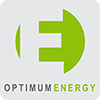IBBR Facility Becomes More Energy Efficient Through Optimization
Institute for Bioscience and Biotechnology Research
Implementing OptiCx™ platform with OptimumLOOP™ nearly doubles chiller plant output while increasing reliability of the IBBR facility, a University System of Maryland joint research enterprise.
Project Summary
Cutting energy use in research labs is notoriously tough. But when the state of Maryland committed in 2011 to aggressively reducing its energy consumption—20 percent by 2020 James Johnson knew he had to find a way to make the Institute for Bioscience and Biotechnology Research (IBBR) more efficient. Calling the 110,000-square-foot facility “as big an energy pig as there was out there,” Johnson, IBBR’s director of facilities and lab services, took a close look at the environmental stabilization plant.
The mandate gave Johnson the opportunity to upgrade plant equipment in 2014. When he started the optimization project, the plant was consuming energy at 0.9 kW/ton and operating at just 50 percent output. In the first year of optimization, IBBR’s plant cut energy use by an average of 30 percent while almost doubling its output.
“Optimum is different. I’ve got a plant that is running at absolute maximum efficiency.”
—James Johnson, director of facilities and lab services
ENVIRONMENTAL STABILIZATION PLANT
Two 450-ton electric centrifugal chillers, two condenser water pumps, two chilled water pumps, two cooling tower cells (all variable speed)
Cooling capacity: 900 tons
Chilled water production: more than 1.2 million ton-hours IBBR FACILITY 110,000-square-foot building 3,800 hours of cooling per year
Benefits
• Energy savings
• Cost savings
• Improved system resilience
• CO2 emissions reductions
Plant Efficiency Improvement
Annual average plantwide efficiency, pre-optimization: 0.9 kW/ton
Annual average plantwide efficiency, post-optimization: 0.57–0.65 kW/ton
Utility savings (annual, projected) Electrical energy savings: 266,836 kWh/year
Electrical demand reduction: 18 Kw
CO2 emissions reductions: 128.38 tons/year
Financial savings (annual, projected)
Annual operations costs: $36,000
Estimated ROI: 6.25 years
Challenge: Increasing the efficiency of a new plant
When Maryland charged Johnson with reducing energy consumption, the environmental stabilization plant was only five years old and had few operational maintenance issues. So Johnson reviewed plant components. Consulting with engineers from Optimum Energy, he found that optimizing each piece of equipment individually, as part of the whole system, could increase the plant’s overall efficiency considerably. “Being able to reduce energy consumption through optimization is significant. If we don’t have to run the water higher education CASE STUDY chillers as hard in the summer months, then we can reduce a good amount of the energy used to condition the outside air,” says Johnson. Johnson wanted to go beyond energy efficiency to also increase reliability and redundancy. IBBR connects award-winning scientists in interrelated fields of study with the goal of accomplishing world-class interdisciplinary bioscience and biotechnology research that leads to real-world advances. Anything the facilities engineers can do to further stabilize lab environments is vital to the mission. Plus, IBBR is in Rockville, Maryland, where the conditions range from icy, snowy winters to hot, humid summers. The two 450-ton, variable-speed electric centrifugal water chillers labor year-round to cool 110,000 square feet, providing 3,800 hours of cooling annually. Johnson needed to ensure that the chillers were working at optimal levels, regardless of outside conditions. “Optimum Energy gave us a lot of the options we were interested in, including making maintenance and operations more flexible and extending the life of the equipment,” he says, explaining that the solution offered a greater return on investment than other options.
Solution: Optimum Energy OptimumLOOP
IBBR converted to an all-variable flow plant, with Optimum Energy’s OptiCx™ Platform as the optimization and control layer. OptimumLOOP™ calculates the most efficient operation of the entire chilled water system and optimizes plant performance in real time, dynamically adapting to changes in load, weather, and occupancy to yield the lowest possible kW/ton while maintaining the optimal lab temperature. “In 2014, our plant baseline was about 0.9 kW/ton,” says Johnson. “By the end of 2015, it was 0.57–0.65 kW/ton.” Depending on conditions, the environmental stabilization plant is now running 27 to 37 percent more efficiently.” “We’re able to run one chilled water pump at 55 Hz instead of 60 Hz. By itself, that’s not a huge gain, but multiply that by two, and then run those chillers more efficiently at a lower flow—running individual pieces of equipment at more efficient speeds all wraps up to one big number,” he explains. Through OptiCx Chiller Diagnostics, Johnson receives monthly maintenance reports with prioritized recommendations, which helps keep the chillers running at peak performance. The solution’s analytics and its measurement and verification capabilities also allow him to continually monitor HVAC system performance, efficiency, and energy savings. Result: Almost twice the energy for the same cost. When Johnson began looking at a plant optimization solution, IBBR’s environmental stabilization plant was running at about 50 percent output. After running at full optimization for about a year, the facility has increased to 90 percent output—and its energy consumption remained flat. “Optimum is different. The solution looks at how each piece of equipment runs and figures out at what speed, what pressure, and so on it would work optimally,” says Johnson. “I’ve got a plant that is running at absolute maximum efficiency.”

